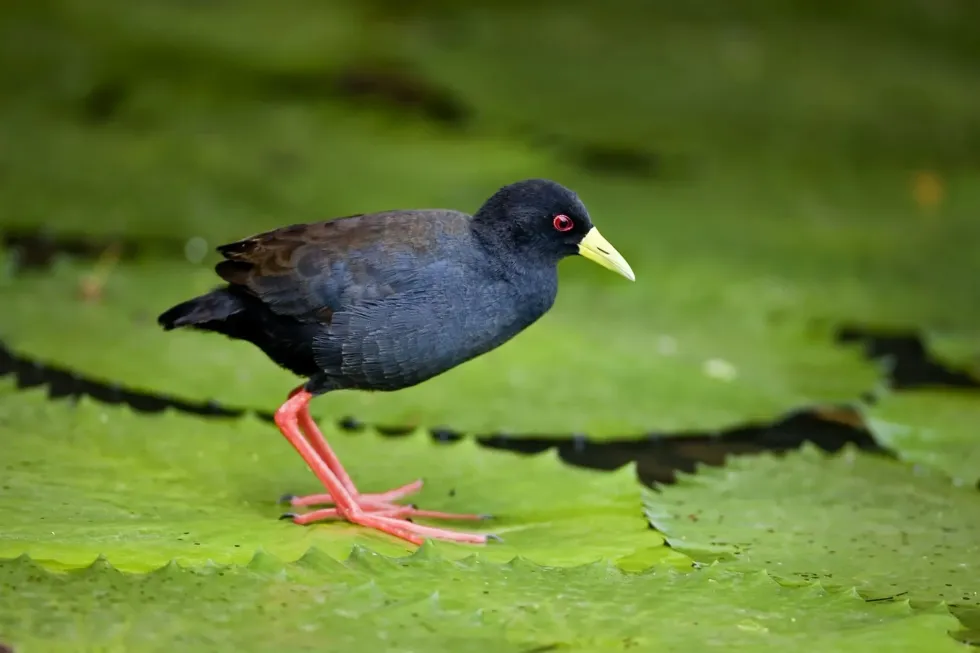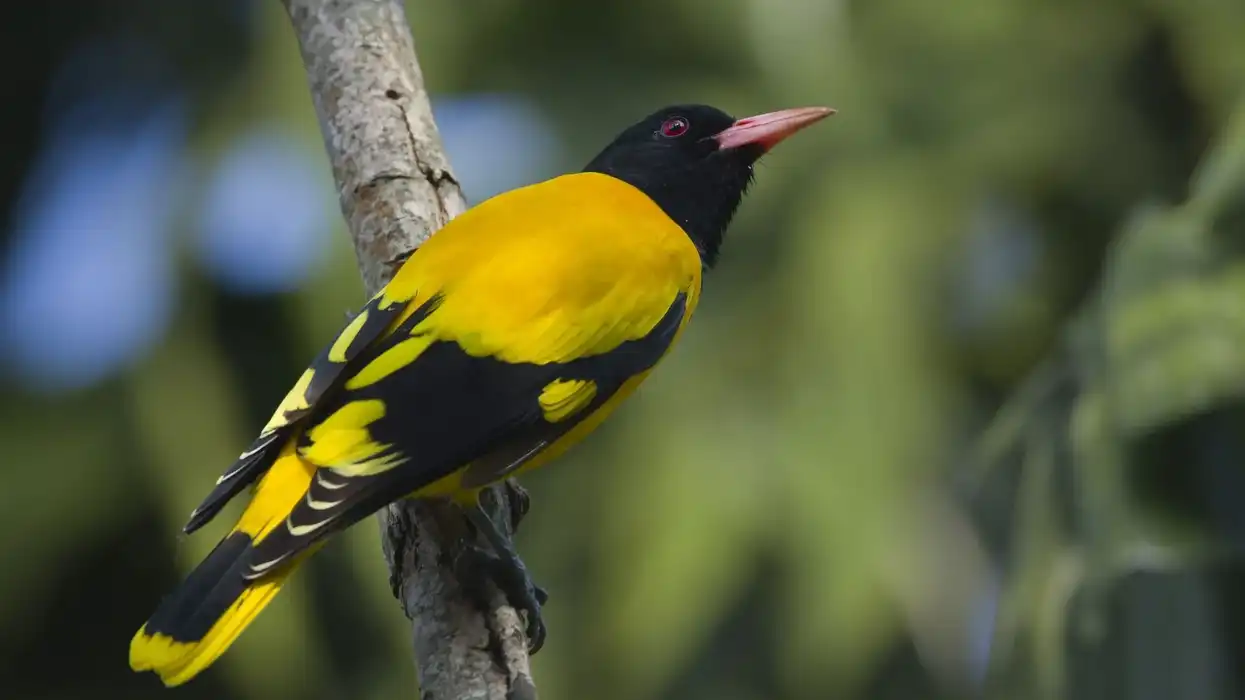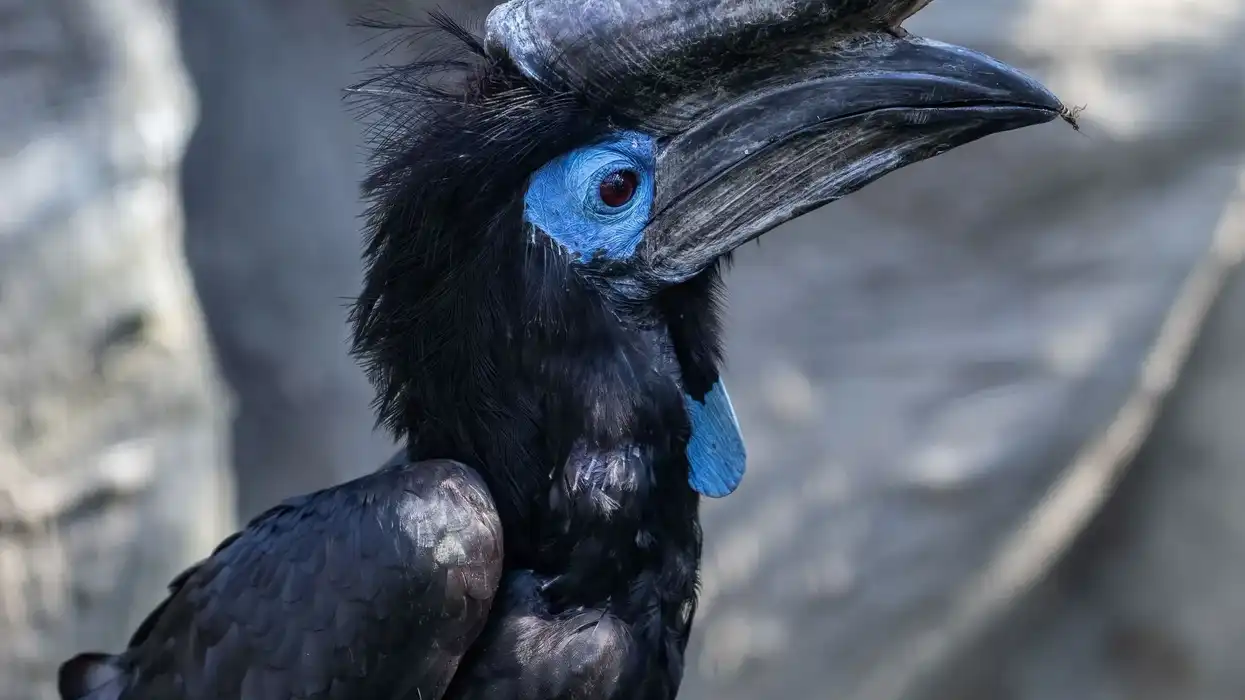The black crake (Zapornia flavirostra), occasionally known as the African black crake, is a member of the Rallidae family which mostly consists of waterbirds. Black crakes are found all over the sub-Saharan regions of Africa.
Black crakes are known for their slate-black feathers, red eyes, yellow bill, and weird but intriguing bright red legs and feet with long toes. These long toes are actually useful in digging underwater to forage for food. Black crakes are aggressive towards others during the breeding period but are typically docile and harmless.
The current population of the black crake is stable as they are found in many African countries. During a drought, they can migrate to a different region and thrive in their new surroundings. Hopefully, they continue to thrive in their natural habitat and get nowhere close to being endangered.
If you liked these true facts about black crake, check out common goldeneye facts and green heron facts too!
Black Crake Interesting Facts
What type of animal is a black crake?
The black crake (Zapornia flavirostra), also known as the African black crake, is a semi-aquatic waterbird. The black crake is one of the most common birds in sub-Saharan Africa and is easily recognizable thanks to its black plumage, bright orange legs and feet, and long toes.
What class of animal does a black crake belong to?
As is the case with all Gruiformes, or birds of the world, the black crake belongs to the Aves class of animals. This bird species belongs to the Zapornia genus and to the Rallidae family of birds and is related to other wading birds, like coots and common gallinules.
As is the case with many rails, the black crake has short wings for short-distance movements.
How many black crakes are there in the world?
The black crake (Zapornia flavirostra) is a common waterbird in sub-Saharan Africa. These birds can be found wading through agricultural and vegetation fields.
Their movements are sometimes subject to a seasonal drought that destroys most of the freshwater range. Subsequently, the birds move to different swamps and marshes. As a result of this widespread population distribution in both breeding and nonbreeding black crake individuals, accurate population data cannot be stated.
According to the IUCN, the population number of this bird species including breeding and nonbreeding individuals is estimated to be around 1 million.
Where does a black crake live?
The black crake's range map is usually tropical and temperate climates in arid zones. These birds frequent freshwater habitats as they prefer grassy marshes in the open.
These birds can be found throughout the sub-Saharan range as they are always on the move in search of food, mainly during a seasonal drought.
What is a black crake's habitat?
The black crake (Zapornia flavirostra) is a semi-aquatic waterbird and spends most of its time in and around a freshwater habitat. This bird prefers lakes, ponds, and flooded areas with lots of plants and grass which they can use as a cover when nesting and roosting.
These semi-aquatic bird species are often found in and around dense vegetation in human settlements or the wild. They are often found feeding on parasites or insects, a major part of their diet, directly off of the body of a hippopotamus, with whom they share a symbiotic relationship.
Who do black crakes live with?
The black crake (Zapornia flavirostra) species, like many rails it is related to, is a solitary wading semi-aquatic bird. These birds mainly come together during the breeding season.
Black crake can often be seen wading through the water bodies in their habitat range and forage in the open. Unlike other species of the family Rallidae, black crake is not secretive and will walk without cover along the vegetation shores with plants and poke the water with their long toes in search of fish or frogs for feeding.
Since many African regions experience seasonal drought, movements can be seen in this bird as they will migrate locally to new areas for feeding and breeding.
How long does a black crake live?
Based on data provided by the IUCN, the African black crake's lifespan is an average of 3.5 years.
How do they reproduce?
The black crake (Zapornia flavirostra) is a monogamous species and will form bonds with the other sex that last until the breeding season is over. This species is one of the few in the world that breed throughout the year under suitable conditions.
The courtship is a long process that involves feeding and preening. Flapping wings and bows are used in an effort to attract the opposite sex.
Sometimes they can also be heard performing a 'krrok-krrraa' call. These birds are often loud and show no signs of being secretive during the breeding season.
The nest is a deep bowl of reeds or other aquatic plants above water that provides cover to the eggs. In certain cases, the nest can also be placed on the plants on the ground at a height of 118.1 in. (3 m).
After fertilization, the female will lay at least six eggs in the nest, with an average of three eggs per clutch. The eggs are white with brown spots.
Both parents take part in the incubation process that is between 13-19 days. The young are fledged for a month or so. This bird might breed three to four times a season.
What is their conservation status?
The IUCN Red List has evaluated this species under the Least Concern category.
Black Crake Fun Facts
What do black crakes look like?

The description for both the male and female birds of this species is similar with no visible differences in body types. An adult black crake is completely black in color and an olive tone can be found on the upper parts of their bodies.
The facial features of this bird consist of a bright yellow bill and red eyes. The legs and feet are bright red and when they are not breeding, they have a duller red color.
In the case of the young, the yellow bill is similar but the legs and feet have a duller tone of red just like nonbreeding adults. The overall appearance of the young is a dull brown color.
How cute are they?
The black crake is not very cute, as is the case for rails in the family Rallidae, for example, the king rail. However, they are unique due to the slate black colored plumage of the adult along with their bright red legs and feet. The brown plumage of the young does not help them n gaining cuteness points.
How do they communicate?
Black crakes, like other rails, is a quiet bird but can be very vocal during the breeding season. Their advertising call is in the form of a duet where one bird will make a call and the others will join in.
How big is a black crake?
The black crake (Zapornia flavirostra) is a small bird and reaches an average body size of 7.4-9 in (19-23 cm) and a wingspan of 9.8 in (25 cm) as adults.
How fast can a black crake fly?
African black crake flying speed is currently not classified as these birds are short-distance travelers.
How much does a black crake weigh?
Adult black crakes are neither too light nor too heavy, weighing an average of 2.4-4.1 oz. (70-116 g).
What are the male and female names of the species?
There are no names assigned to either sex.
What would you call a baby black crake?
An African black crake baby is called a chick, as is the case with most bird species. Chicks are born after an incubation period of 13-19 days.
African black crake chicks are brown in color and have dull red legs and feet.
What do they eat?
Black crakes (Zapornia flavirostra) are omnivorous birds and are often found hitching rides on the back of the Hippopotamus feeding on the parasites. The diet of this bird includes seeds, small crustaceans, frogs, insects, and fish and crab carcasses.
Are they poisonous?
No, these birds are not poisonous. They are usually docile birds but become aggressive during the mating season and attack other rail species around them. This attack can range anywhere between a stern warning to a charge.
Would they make a good pet?
No, black crake is not a good pet as it is a wild species and cannot form a relationship with humans. As a pet, there are many causes of concern that stop them from being pets. For example, a major part of their diet are parasites that they feed off of animals they have a symbiotic relationship with.
Did you know...
The long toes and bill of this bird help it in foraging the land underwater for crustaceans and seeds.
The moorhen belongs to the same species as the black crake, which is the Rallidae family.
Black crakes have many synonyms of their scientific name Zapornia flavirostra. Some of them are Limnocorax flavirostra, Porzana flavirostris and Amaurornis flavirostris.
What role do black crakes play in the ecosystem?
Black crakes (Zapornia flavirostra) are great dispersers of seeds and help in the growth of plants and trees in the ecosystem.
Are black crakes endangered?
No, this bird is not endangered. It is classified as a species of Least Concern with no special protection plans aimed towards its conservation. This crake is one member of the black crake species including the black-tailed crake and the black-banded crake.
Here at Kidadl, we have carefully created lots of interesting family-friendly animal facts for everyone to discover! Learn more about some other birds from our northern gannet surprising facts and sarus crane surprising facts pages.
You can even occupy yourself at home by coloring in one of our free printable black crake coloring pages.










